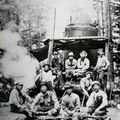Though not widely acknowledged, J-Town Toronto did exist. Very little of it can be found today and, back in the day, no one called it J-Town or Little Tokyo or anything. Probably because it formed for a relatively short time just after 1949 when Toronto’s City Council lifted its restriction of Japanese Canadians living within its confines. It continued through to the early 1980s when most had moved out of the area.
Many Japanese Canadian families and individuals lived in the area roughly bordered by Bay Street in the east, Spadina in the west, Queen in the south, and Bloor in the north. My family lived in the attic of a rowhouse on McCaul Street near Dundas, a few steps away from Orde Street Public School and the Art Gallery of Ontario. The Nikkei didn’t live in grand estates; instead, they inhabited row houses or apartments-to-let. I recall visiting the Sugimotos on Dundas. Their house was so narrow, I could spread my arms wide and touch each wall. I’m sure this is a false memory, but the point is clear.
The community started as a Jewish immigrant area. A garment district flourished there as a result. Jewish delis, like Shopsowitz Delicatessen and Switzer’s, two of over 100 delis in the early 1960s, drew me to the area in my young adulthood. I mention the Jewish community because Jewish landlords and businesspeople were the only ones in the city to rent to and hire Japanese Canadians. I once heard that Sammy Taft, a Spadina haberdasher who invented hockey’s “hat trick” (score 3 goals in a game and you get a free hat), would stand in front of his store every morning to entice anyone with black hair inside as his first customer. Superstition had it that if a black-haired customer was the first of the day, the sales would be plentiful that day. It doesn’t matter why, but they sure welcomed the Nikkei community. The real reason may have been the fact that the Jewish people understood oppression.
The first Japanese restaurants were established in the area. Nikko Gardens above Furuya (more on it later) was a fancy place serving only the best Japanese food. Legend has it that the owners, Gus and Jim Kadonaga (brothers), hated each other. Gus stayed in the front as the maître’d and Jim in the back to manage the kitchen. It could’ve been the reverse actually. In any case, the place was a must for families to celebrate major birthdays and anniversaries. The backroom was a meeting place for JC organizational work. The Japanese Canadian Cultural Centre Committee held their first meetings there. The Japanese Canadian Citizens Association held heated discussions about redress there as well. That’s where the redress movement split into two factions, each with different goals.
A Japanese cafe sat near the corner of Bay and Dundas. The Ginza featured a long counter and some tables and chairs. They served simple teishoku and even ochazuke! Tsukemono like denbatsuke (invented in the New Denver BC internment camp during WWII) and karashina. I understand they also served “Canadian” food, like hamburgers and chopped steak. Got to survive after all.
Japanese grocery stores dotted the landscape as well. Inhabitants needed their rice and tofu. The Toronto Buddhist Church, which started on Huron Street, running south of Dundas near Spadina, opened a food co-op at Huron and Dundas to supply essentials to the neighbourhood. The Co-op was eventually taken over by private interests and reopened as Furuya Japanese Food. It featured an endless array of Japanese products. The butcher in the back was Mr. Ishida (don’t know his first name) and his wife took care of customers at the counter. Mrs. Ishida always had a smile for me. She was wonderful.
Other grocery stores in the area included Sanko Trading and Dundas Union. Dundas Union was a transplant from Vancouver where it started life as Union Fish, a co-op on Powell Street for BC fishermen. They served the finest and freshest fish. The Ryojis owned the store to serve the Nikkei community in Toronto. I heard a rumour that it started on the Danforth in the east end but soon moved to J-town since the customer base was there. In any case, Dundas Union, a dark interior with floor-to-ceiling wooden shelves lining the walls, was packed with Japanese products. The tofu was freshly made every day as well as manju and mochi. Sacks of rice lined the basement. Someone there came up with the brilliant idea to pack a van with the products and drive it around to the various Nikkei families in town.
By the 1970s, most Nikkei had moved out of the area to the near and far suburbs. My family moved to an Old Riverdale house because of me! They needed more room. So, they moved at the dawn of the 1950s to a two-storey semi-detached brick home that cost a whopping $8000! I believe the van came by every week since Mrs. Miyamoto, a popular and excellent caterer of Japanese dishes lived a few doors away from our place. At first, my dad carried the 100 pounds of rice down to our basement. That job fell to me once I became a teenager. Meanwhile, my mother placed her order with the driver who gathered the products and brought them inside. My mother then paid for the groceries. A wonderful service which ended when the Nikkei community became too spread out or the driver, a tall, thin man with a sad face, retired.
As a side note, Mrs. Ruth Ryoji became one of Toronto’s best caterers of Japanese food. She was very popular at the Japanese Canadian Cultural Centre.
I will continue next month with more about our lost J-town.
© 2019 Terry Watada






